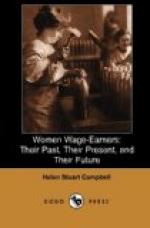One cheering token of progress is the increased discussion as to methods of training and the necessity of organization among women themselves. Ten years ago only a voice here and there suggested the need of either. In 1885, at the meeting of the British Association for the Advancement of Science, Miss Sarah Harland, lecturer on Mathematics at Newnham College, insisted that educated gentlewomen must have larger opportunity for paying work. The three qualifications in all work she stated to be: (1) Organization on a large scale; (2) Permanency; (3) Giving returns that will enable the salaries paid to compete with those of teachers.
She regarded dressmaking as the trade which could most readily organize and meet the other conditions specified, and millinery as the trade which would come next. Until such organization and its results have gradually altered present conditions, it will be true for all workers, on both sides of the sea, that not health alone but life itself are continuously endangered by the facts hedging about all labor. Dr. Stevens, the head of St. Luke’s Insane Asylum in London, in a paper read before the Social Science Association, said:—
“It may be stated with great confidence that a prolific cause for the rapid and extensive increase of insanity in this country is to be found in the unceasing toil and anxiety to which the working-classes are subjected, this cause developing the disease in the existing generation, or, what is quite as frequently the case, transmitting to the offspring idiocy, insanity, or some imperfectly developed sensorium or nervous system. The agitated, overworked, and harassed parent is not in a condition to transmit a healthy brain to his child."[49]
Accepted as true in 1857, the words are not less so to-day, when cheap labor swarms, and the unemployed number their millions.
How best to combine and to what ends, is the lesson taught in every form of the new movement for organization among women. To learn how to work together and what power lies in combination, has been the lesson of all clubs. Among men it has counted as one of the chief educating forces, but for women every circumstance has fostered the distrust of each other which belongs to all undeveloped natures. For the lowest order of worker even, the “Working-Woman’s Journal,” published in London and the organ of the Working-Woman’s Protective Union, has for the last year recorded, from month to month, the gradual progress of the idea of combination, and the new hope it has brought to all who have gone into trades unions.
With us there has been equal need and equal ignorance of all that such combinations have to give. They mean arbitration rather than strikes, and the compelling of ignorant and unjust employers to consider the situation from other points of view than their own. They compel also the same attitude from men in the same trades, who often are as strong opponents of a better chance for their associates among women workers in the same branches, as the most prejudiced employer.




